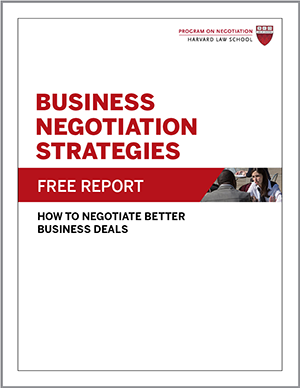
Conventional wisdom, not to mention the popularity of no-haggle car buying, suggests that many people anticipate important negotiations with the same dread they reserve for root canals. And stress at the bargaining table can’t be avoided.
Unfortunately, stressed-out negotiators tend to be less effective than their calmer counterparts, according to research by Kathleen O’Connor of Cornell University; Josh Arnold of California State University, Long Beach; and Andrea Maurizio, also of Cornell.
In their experiments, pairs of undergraduate students negotiated issues concerning a hypothetical class trip. The more stress at the bargaining table that students felt before negotiating, the less value they claimed in the task.
Notably, stress levels were higher among students who perceived the upcoming negotiation as a threat than among those who viewed it as a challenge.
When individuals felt they lacked the negotiating skills and resources needed to perform well, they viewed the task as a threat and experienced stress. By contrast, those who believed they could meet or exceed the requirements of the task viewed it as a challenge and kept their stress levels in check. Those who approached the negotiation as a challenge also felt less fearful and more confident and optimistic than threatened negotiators.
In the study, students who viewed negotiation as a threat were more passive and, when they did act, spent more time dividing up the pie than exploring tradeoffs that might have expanded the pie. Though they may have been as skilled as their more confident peers, the negotiators who felt threatened chose the wrong tactics—resorting to requests and demands when problem solving was needed.
The negotiation lesson is clear: When encountering negotiation examples in real life, if you tend to fear negotiations, do whatever you can to keep stress levels low. Improve your pre-negotiation confidence by preparing thoroughly, carefully exploring your outside alternatives, or best alternative to a negotiated agreement (BATNA), and reminding yourself that the other party may be feeling stressed, too. When you can’t control your stress, make an extra effort to stay actively engaged in the negotiation process and to collaborate with your negotiating counterpart as much as possible.
What have you done in situations of extreme stress at the bargaining table?
Related Business Negotiations Articles:
Negotiation Skills in Business Communication: Heading Off Deception
Examples of Negotiation in Business: Sunk Costs
Contingency Agreement: The Risks and Pitfalls of Issuing Drafts
Real World Negotiations Examples: Bargaining for a New Car
Adapted from “The Stressed-out Negotiator,” first published in the Negotiation newsletter.
Originally published March 2011.






The word “Stress” actually relates to wear and tear as when the rubber meets the road on a tire or the brake pads pressing up against the rotor in the wheel. The term as it applies to living organisms was first introduced by Hans Seyle in the 1930’s who defined it as the consequence of the failure of an organism (human or animal) to respond appropriately to emotional or physical threats, whether actual or imagined. Thus stress symptoms are the manifestation of a chronic state of responses to stress triggers that are actually benign. Even a thought can set off the same response mechanism that would be in play while standing in front of a hungry lion. Hence, Seyle’s definition still reaches to the heart of stress management; the idea of the response being inappropriate and engaging in a process of altering ones misperception of pending disaster or imminent danger.